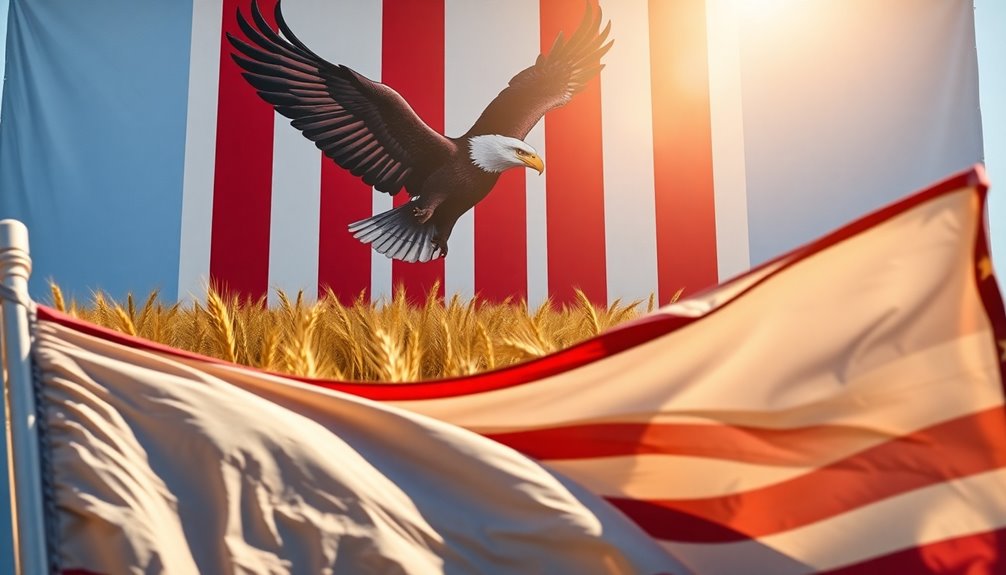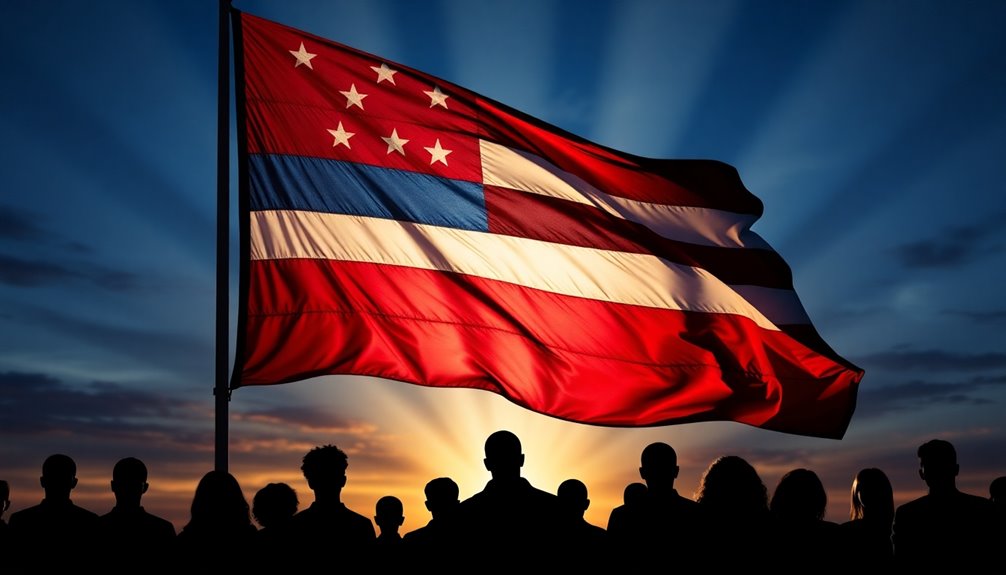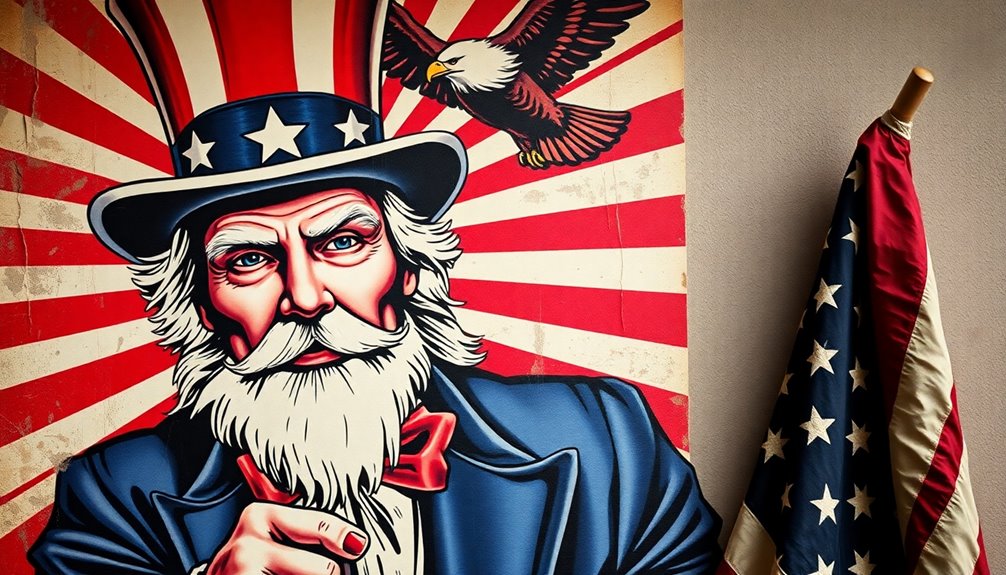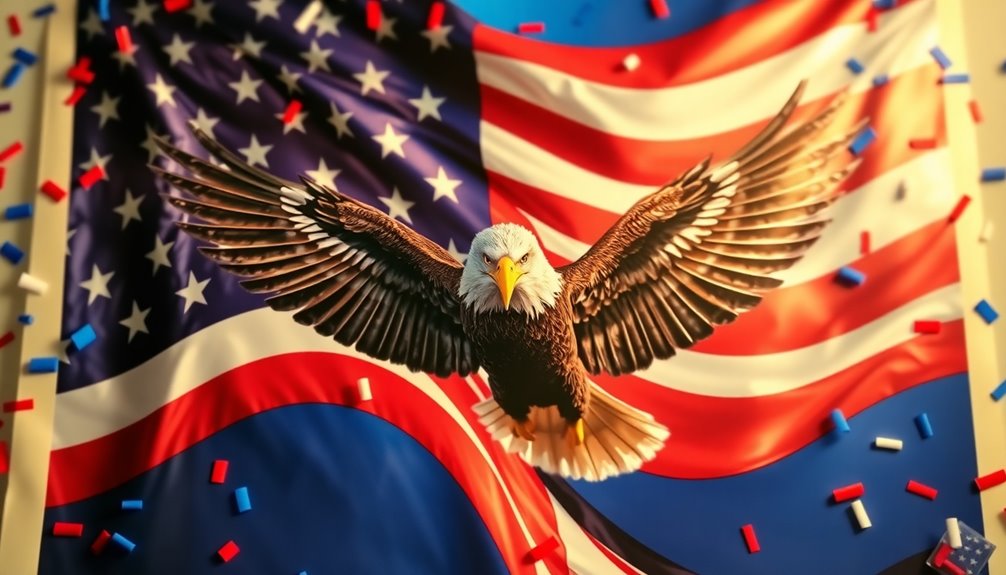The "I Want YOU for U.S. Army" poster uses patriotic symbolism to boost American pride and enlist soldiers. Uncle Sam, with his strong gaze, represents the U.S. government and invites you to take action. The bold colors red, white, and blue remind you of the American flag, sparking feelings of honor and loyalty. This powerful imagery creates a special connection to national identity and makes you want to serve your country. During World War I, it reached millions and inspired many to enlist. Want to discover more about how this poster shaped patriotic pride? There's so much more to explore!
Key Takeaways
- The poster features Uncle Sam, a personification of the U.S. government, representing national identity and duty.
- The use of red, white, and blue colors evokes feelings of honor, loyalty, and sacrifice associated with the American flag.
- Uncle Sam's stern expression conveys a sense of responsibility and urgency, enhancing the emotional appeal for military service.
- The phrase "I Want YOU" serves as a direct call to action, tapping into patriotic sentiment and civic duty.
- The poster's imagery effectively creates a strong emotional connection, motivating enlistment and fostering national pride during wartime.
Overview of the Recruitment Poster

When you look at the iconic recruitment poster created by James Montgomery Flagg, you can immediately sense its powerful call to action. This poster features Uncle Sam, the national personification of the U.S. government, urging citizens to enlist during World War I. The bold phrase "I Want YOU for U.S. Army" grabs your attention, making it feel personal and urgent.
The colors red, white, and blue echo the American flag, stirring feelings of national pride. Uncle Sam's stern look and pointing finger create an emotional appeal, urging you to feel a sense of responsibility and duty to your country. You can almost hear him saying, "It's your turn to serve!"
First appearing on July 6, 1916, in Leslie's Weekly, this recruitment poster has become a lasting symbol of American wartime propaganda.
It's not just a picture; it's a message that resonates with the spirit of patriotism. This powerful call to duty has inspired countless Americans to take action and join the fight. The blend of patriotic symbolism, emotional connection, and urgency makes this poster a remarkable piece of history that continues to inspire.
Key Patriotic Symbols Used

Patriotic symbols in the recruitment poster play an essential role in conveying its powerful message. One of the most recognizable symbols is Uncle Sam. He stands as a personification of the U.S. government, inviting you to take action. With his stern yet friendly expression, Uncle Sam directly addresses you with his iconic pointing finger, creating a personal connection. His message, "I Want YOU for U.S. Army," speaks to your sense of duty and civic duty, making you feel important.
The colors red, white, and blue in the poster represent the American flag, stirring feelings of national pride. They remind you of the values of honor and loyalty that define the American spirit. This imagery evokes strong emotions about sacrifice and service to the nation, encouraging individuals to step up and contribute.
As you look at the poster, you can't help but feel inspired. It captures the essence of what it means to be an American during challenging times.
Historical Significance During WWI

During World War I, recruitment posters played a huge role in getting people to join the military.
Just think about the famous "I Want YOU for U.S. Army" poster—Uncle Sam's serious look and bold colors really tug at your heartstrings!
These powerful images not only called for action but also made you feel proud to support your country during such a challenging time.
Recruitment Strategies in Conflict
Recruitment strategies in conflict played an essential role in shaping military participation during World War I. One of the most famous tools was the "I Want YOU for U.S. Army" poster featuring Uncle Sam. This poster used patriotic symbols, like the colors red, white, and blue, to spark national pride and encourage enlistment.
When you saw Uncle Sam's stern gaze and pointing finger, it felt like a personal call to duty. The poster not only appealed to emotions but also prompted individuals to think critically about their role in society and the importance of military service during times of national crisis. The effective use of emotional intelligence in crafting such messages helped to resonate deeply with potential recruits. Additionally, the strategies employed in the poster reflect a broader trend of utilizing unique experiences to connect with the audience on a personal level.
Here are some key points about these strategies:
- Patriotic symbols made people feel proud.
- Emotional appeal was vital for recruitment.
- Imagery connected to American values resonated well.
- The poster reached over 452 million people!
- Visual propaganda was a powerful tool for enlistment.
These strategies were influenced by earlier British posters and designed to resonate with people's feelings. By transforming patriotic sentiment into a message for military service, the poster showcased how effective visual propaganda can be. It helped many Americans feel a sense of responsibility, leading to a significant increase in enlistment during a time of global conflict. Additionally, the success of the poster demonstrated the importance of educational toys in fostering skills like critical thinking and emotional intelligence in children, much like how patriotism encouraged a sense of duty in adults.
Emotionally Charged Imagery
As the world plunged into conflict, emotionally charged imagery became an essential tool for galvanizing public support and encouraging enlistment in the military. The famous "I Want YOU for U.S. Army" poster, featuring Uncle Sam, uses bold red, white, and blue colors to spark feelings of national pride. You can't help but feel a sense of responsibility when you see Uncle Sam's serious face and outstretched finger, as if he's personally calling you to duty.
This poster isn't just a piece of art; it's a powerful form of propaganda. It influenced public sentiment at a time when the U.S. needed military support. By personifying the U.S. government through Uncle Sam, the message feels more urgent and relatable. You see him, and you know he's counting on you!
Emotionally charged imagery like this made a lasting impact. It turned everyday citizens into potential soldiers, urging them to enlist. The appeal to patriotism and duty was strong, and it helped rally the nation during WWI.
This poster became one of the most iconic images of American propaganda, showcasing the power of imagery in uniting a country during tough times. Moreover, the impact of such imagery can be likened to the way toilet maintenance ensures a reliable and efficient system, underscoring the importance of civic duty in maintaining national strength.
Emotional Resonance and Impact

While viewing posters steeped in patriotic symbolism, you can't help but feel the emotional weight they carry. These posters, especially the one featuring Uncle Sam, tap into powerful feelings of national pride. The bold red, white, and blue colors instantly remind you of the American flag. Uncle Sam's serious expression and commanding pose create a strong emotional appeal, making you take the recruitment message seriously.
Here are some key feelings these posters evoke:
- Duty: They remind you of your responsibility to your country.
- Sacrifice: You think about the sacrifices made by others.
- Personal Responsibility: The phrase "I Want YOU" makes it personal and direct.
- Iconic Imagery: Uncle Sam pointing at you feels like a challenge.
- Historical Success: These symbols helped recruit many during World War I.
The combination of these elements turns the poster into more than just a message; it creates a call to action.
It stirs feelings of urgency and importance, inviting you to reflect on your role in serving the nation. This emotional resonance is what makes patriotic symbolism so impactful!
Cultural Legacy of Uncle Sam

Uncle Sam isn't just a character; he's a key part of what it means to be American! His image helps represent our national identity, showing values like duty and pride.
Plus, he's been used in all sorts of ways over the years, from political cartoons to fun adaptations, making him a lively part of our culture today!
National Identity Representation
Capturing the essence of American patriotism, the iconic "I Want YOU for U.S. Army" poster shows Uncle Sam, a true representation of national identity. This powerful image emerged during World War I, calling citizens to their civic duty and showcasing patriotic symbolism.
The vibrant red, white, and blue colors connect directly to the American flag, stirring feelings of pride and unity.
Here are some key points about Uncle Sam and his role in American culture:
- He symbolizes American values like freedom and democracy.
- His stern expression and pointing finger remind you of your responsibility to support your country.
- The poster's popularity has made Uncle Sam a beloved cultural icon.
- It's a reminder of the importance of civic duty, especially during times of war.
- Over the years, the poster has become a lasting emblem of American nationalism.
Political Commentary Tool
Through the lens of political commentary, the "I Want YOU for U.S. Army" poster showcases Uncle Sam as a powerful symbol of patriotic duty. His stern gaze and commanding finger point directly at you, creating a strong call to military service. This connection to national pride is hard to ignore! The vibrant red, white, and blue colors echo the American flag, enhancing the poster's emotional appeal and urgency.
This iconic image served as an essential tool for wartime propaganda during World War I. It encouraged enlistment when tensions were rising globally. Uncle Sam has become more than just a recruitment figure; he's a cultural icon representing American values. His image pops up in various political commentaries, reminding us of our responsibilities as citizens.
When you see Uncle Sam, you feel a sense of duty and pride. He represents not just the call to serve, but also the larger ideas of patriotism and community.
This poster doesn't just ask for recruits; it invites you to be part of something bigger. It's a joyful reminder that, together, we can uphold the values that make our nation great!
Cultural Adaptation Over Time
The evolution of Uncle Sam reflects the changing landscape of American culture and identity. This iconic figure has transformed from a vague representation of the U.S. government into a beloved symbol of patriotism.
Thanks to political cartoonist Thomas Nast, Uncle Sam got his tall, thin figure and stars-and-stripes outfit. His famous "I Want YOU" recruitment poster from 1917 really boosted his role as a symbol of national duty. It showed how effective visual propaganda can be in rallying Americans, especially during the World Wars.
Over the years, Uncle Sam has become more than just a military figure. He's now a cultural icon appearing in books, movies, and even merchandise! His image adapts to fit contemporary contexts, sparking discussions about what it means to be American today.
Here are some fun facts about Uncle Sam:
- He's often seen with a top hat and a goatee.
- The name "Uncle Sam" comes from a meat packer named Samuel Wilson.
- He's used in political cartoons to comment on national issues.
- Uncle Sam represents American identity and unity.
- His image encourages people to think about their national duty.
Isn't that exciting?
Modern Interpretations of Symbolism

Patriotic symbolism in modern posters has evolved considerably, reflecting contemporary values and social issues while retaining the essence of American pride. You might notice that the iconic "I Want YOU" poster still uses red, white, and blue colors, which evoke feelings of patriotism. Uncle Sam remains a beloved figure, adapting to address today's social issues while keeping ties to military service.
In recent years, you might see Uncle Sam's image in protest graphics. These modern adaptations show how patriotic symbols can also critique government policies. This transformation highlights the versatility of Uncle Sam in promoting social commentary and activism.
The psychological principles that sustain love can also be observed in how these symbols foster community and connection among citizens.
On digital platforms, his image is creatively used in campaigns that resonate with younger audiences, demonstrating how relevant patriotic symbolism still is in recruitment efforts.
Cultural events, like the Fourth of July, often feature different versions of Uncle Sam. These images reinforce national identity and show how the poster's symbolism continues to evolve while capturing the spirit of American values.
Frequently Asked Questions
How Does the Uncle Sam Poster Use Patriotic Symbolism?
The Uncle Sam poster grabs your attention with its bright red, white, and blue colors.
These colors remind you of the American flag, stirring up feelings of pride.
When Uncle Sam points right at you, it feels like he's calling you to serve your country.
His serious expression shows how important duty is.
All these elements combine to celebrate American values, making you feel excited about standing up for your nation!
What Is the Purpose of Patriotic Symbols?
Patriotic symbols are powerful! They create feelings of pride and unity among people.
When you see colors like red, white, and blue, or images like the American flag, you might feel a strong connection to your country. These symbols remind you of the values and traditions that are important.
They inspire action, encourage loyalty, and make you feel part of something bigger. Using these symbols can motivate you to contribute and celebrate your nation!
What Are 3 Patriotic Symbols?
Patriotic symbols are exciting! Three important ones are the American flag, the bald eagle, and the national anthem.
The American flag, with its bright red, white, and blue colors, stands for freedom and unity. The bald eagle represents bravery and strength, soaring high as a symbol of our nation.
Finally, the national anthem brings people together, celebrating our shared values and history. These symbols help you feel connected to your country and its ideals!
What Role Did Symbols Play in America's WW1 Posters?
Symbols played a huge role in America's WWI posters! They grabbed your attention and stirred your emotions.
Think of bold colors like red, white, and blue shining brightly, or the strong eagle soaring overhead. Each symbol told a story, inspiring feelings of bravery and duty.
When you saw Uncle Sam, you felt called to serve. These visual elements made you proud, reminding you that joining the military was about protecting your country and its values.
Conclusion
To sum up, the recruitment poster is a powerful piece of art that uses patriotic symbols to inspire and unite people. Just like a warm hug, it wraps you in feelings of pride and belonging. These symbols, from Uncle Sam to the American flag, remind us of our shared history and values. Their impact reaches beyond the past, influencing how we see ourselves today. So next time you see a poster, think about the meaning behind those vibrant images!











